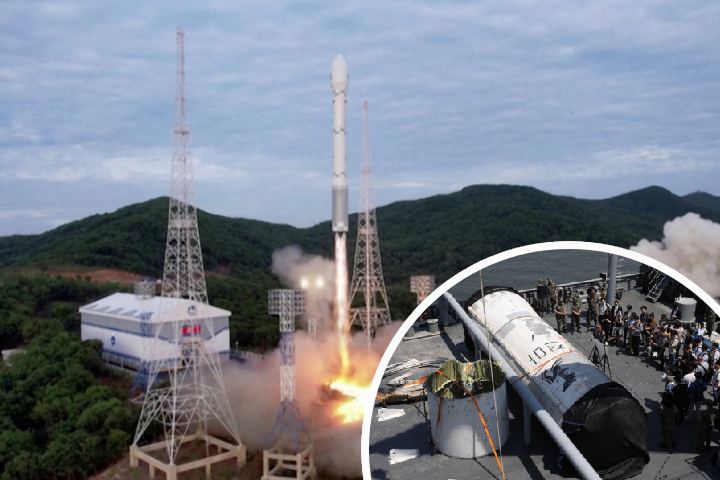


North Korea's official media announced Thursday that Pyongyang had failed to put a spy satellite into orbit for the second time, with the rocket crashing into the sea.
“The flights of the first and second stages of the rocket were normal, but the launch failed due to an error in the emergency blasting system during the third-stage flight,” Pyongyang’s mouthpiece, the Korean Central News Agency (KCNA), said of the launch.
The North Korean space agency, the National Aerospace Development Administration (NADA), announced it launched the reconnaissance satellite Malligyong-1 into orbit using the new-model carrier rocket Chollima-1. It went on to say that "the cause of the relevant accident is not a big issue in terms of the reliability of cascade engines and the system."
Pyongyang has promised a third launch attempt in October to put its first military spy satellite into orbit as part of a plan to create a network of satellites to watch US and South Korean soldiers.
“NADA expressed the stand that it would conduct the third reconnaissance satellite launch in October after thoroughly probing the reason and taking measures,” KCNA reported.
North Korea's first attempt, on May 31, failed shortly after launch when their new Chollima-1 rocket splashed into the sea. The second stage of the launch failed, and state media blamed it on an unstable and unreliable new engine system and fuel.
The launch of nuclear-armed North Korea was criticized by the White House as a violation of several United Nations resolutions. The United Nations Security Council.
It said that the door “has not closed” on diplomacy but added that Pyongyang “must immediately cease its provocative actions and instead choose engagement.”
The White House also stressed that the US is determined to taking all necessary actions to ensure its security and defend its allies, South Korea and Japan.
In the meanwhile, the U.S. The State Department urged North Korea to cease "further threatening activity."
“Space launch vehicles (SLVs) incorporate technologies that are identical to, and interchangeable with, those used in ballistic missiles, including intercontinental ballistic missiles (ICBMs),” a State Department spokesperson said in a statement.
Separately, South Korea said Pyongyang's most recent missile failed. The South Korean military claimed it had tracked the flight since it took off from Pyongyang's Sohae Satellite Launching Ground. It is now attempting to retrieve any wreckage.
In its maiden launch, South Korea retrieved a portion of Pyongyang's failed rocket, including the satellite payload. Seoul stated at the time that the missile did not appear to have military capabilities.
The North Korean launch was criticized by Seoul's National Security Council as a violation of U.N. sanctions. Resolutions of the Security Council prohibiting the development of ballistic missile technology.
Japan issued an emergency alert shortly before 4 a.m. In reaction to the launch, the company used its J-alert broadcasting system. Residents of Okinawa's southernmost prefecture were advised to seek shelter. After 20 minutes, the emergency alert was withdrawn, along with a notification that the missile had passed.
Japan, like the US, criticized the launch, with Japanese Chief Cabinet Secretary Hirokazu Matsuno warning during a televised news conference that Pyongyang's periodic missile launches endanger regional security. "We will strongly protest against North Korea and condemn it in the strongest possible terms," he added.
Parts of the rocket landed in the Yellow Sea, the East China Sea, and the Pacific Ocean, he said.
The launch came three days after the annual military drills between the United States and South Korea, which North Korea refers to as a dress rehearsal for an invasion. The 11-day joint drills, according to North Korea's state media, raise the likelihood of a nuclear confrontation on the Korean Peninsula.
North Korea has attempted multiple times to launch "earth observation" satellites into orbit, with two appearing to be successful, one in 2016. According to foreign observers, the 2016 satellite appeared to be under control, but questions about its transmission operations remained.